Caring for the Pets in Your Family
People aren't the only
ones whose needs you must consider. Family pets come along with their
own list of care requirements. If you are still at the stage of deciding
whether to get a pet or what kind of pet to get, then you should choose
responsibly by considering where you have time in your family's
schedule.
Of course, the place to begin your decision process is in figuring out why you want a pet: |
But you also should
consider how much time your family will have to devote to a pet and
whether the pet's schedule will match yours. A large dog that needs to
be walked three times a day will take a minimum of 312 hours of care a
year. And someone will have to be available mid-day to take the dog for a
walk. Plus, don't forget the need for extra housecleaning that a dog
will generate. And if your family plans to travel without the dog, then
kenneling becomes an issue as well.
On the other end of the
spectrum are goldfish. They're not warm and cuddly, but they're still
enjoyable (and calming). If you put them in a tank with a good filter,
your annual time commitment to feeding and maintenance will come out to
only about 14 hours a year.
tip
Estimated first year
costs for pets run between $75 and $1,500, so be sure to research both
the time and money aspects of a new pet carefully.
In terms of scheduling, you'll need to make a list for each of your pets similar to the lists you made for each family member. Figure 2 shows an example.
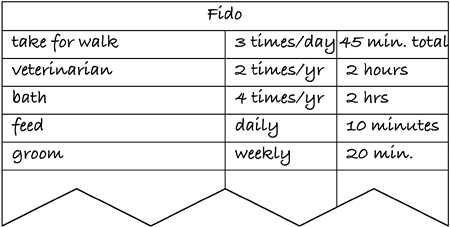
Maintaining Your Home
Now it's time to make a
list of everything that needs to be done concerning the care of your
home. This list will be very long, but we'll show you how to break it
down into manageable pieces and how to slot those pieces into your
family's schedule. By making a thorough list now, you'll ensure that
little details don't “fall through the cracks” and leave you frantically
running around dealing with routine items that have suddenly become
urgent.
Listing Tasks Room by Room
The easiest way to make
your list is for you to spend a few minutes in each room of your home.
Look around and write down anything you can think of that needs to be
done with anything in the room. For example, if you're in the living
room and you have a fireplace, you might come up with a list that
includes the items in Figure 3.
The idea right now is to make a completely comprehensive list. You
don't need to think about categorizing it or sorting it out; that will
come later. Don't be discouraged if your list takes up several pages;
some households will easily have more than 500 entries on their lists.

Assigning Task Frequency
When you think your
list is complete—you can always go back and add items you forgot—it is
time to assign each item a frequency, as shown in Figure 4. Don't get too detail-oriented here. Whenever sensible, try to limit your selection to the following choices:
Daily (examples: open mail, put away toys)
Weekly (examples: take out trash, pay bills)
Monthly (examples: file papers, wash car)
Quarterly (examples: turn mattresses, get oil changed)
Yearly (examples: clean chandelier, file tax returns)
One time only (examples: get new bathroom sink faucet, plant tree in front yard)
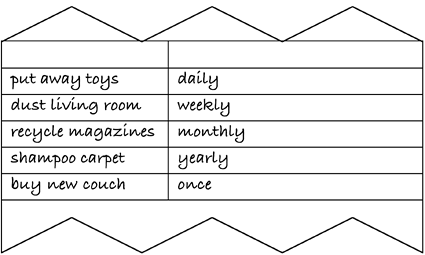
note
If you have more than one home—a summer home, RV, and so on—you should make similar lists for each one as well.
If you need to do
something more than once a day, then list each instance as a separate
item. For example, if you need to run your dishwasher both in the
morning after breakfast and in the evening after dinner, then list the
task like this:
Deciding how often to do
something can be tricky. We all tend to want to assign an ideal
frequency to each task. For example, maybe you were taught that bed
sheets should be changed every week. On the other hand, if your family's
schedule currently is out of control, you may not be changing the
sheets more often than once a month. At least in the beginning of your
new organizing endeavors, consider whether you can feel comfortable—and
still better off than now—by compromising and assigning this task a
frequency of every two weeks.
Scheduling Daily, Weekly, and Monthly Tasks
The next step is to
decide the best time to accomplish each task. The easiest way to do this
is to start with the items that you've decided to do on a weekly basis.
Assign each of these items a specific day of the week. Some assignments
will be obvious; for example, you take out the trash on the day your
neighborhood has trash collection. When it comes to other items, you'll
want to have an outline in place to help make your decisions easier. To
do that, designate a focus for each day of the week. As
a starting point, you can focus one day each week as follows:
Next, deal with the
items your family will do every month. Once again, you'll use your daily
focus plan to decide which day of the week will work best. For example,
if you're going to have your car washed once a month, you'll assign it
to your errand day. On the other hand, if someone in the family is going
to wash the car, that chore might get assigned to the light housework
day. If your family makes an activity out of it—complete with water
fight—family day is a valid option.
note
If you work in an office,
you can try the same daily focus technique at work, having one day of
each week focused on the following:
Because you'll be
doing monthly things only once every four or five weeks, you should also
distribute your monthly tasks throughout the month by assigning them a
week, such as “first Monday of the month” or “third Tuesday of the
month.” Avoid listing anything for the fifth week of the month because
no months contain a complete fifth week. Figure 5 gives you an idea of how your list will start to look.
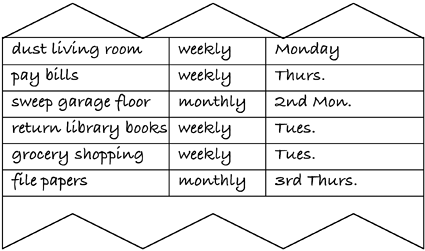
Scheduling Annual Tasks
After you've set up
your plan for daily, weekly, and monthly home maintenance requirements,
you should complete the plan by dealing with the items that your family
needs to do on a yearly basis. Much the same way that you established a
focus for each day of the week, you should now establish a focus for
each month of the year. Your plan might look something like this:
Be sure to consider
the rhythm of your family and your local weather conditions when putting
together your monthly focus plan. For example, it's far better to work
on cleaning out the closets in your children's bedrooms in July when
they are home for the summer. On the other hand, cleaning out a hot
attic in July really is not a very appealing—or healthy—idea.
With your monthly
plan, you can spread the rest of the items on your list throughout the
year. To do that, go back through your list and write the appropriate
month next to each of the remaining items. You can use the examples in Figure 6 as a guide.
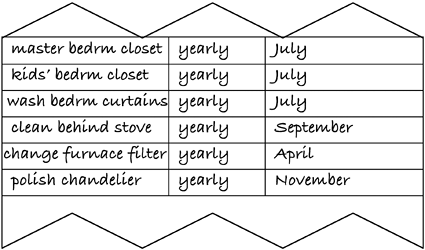
Estimating Time for Tasks
note
Keep in mind that Table 3
does not represent a complete list of common chores because some tasks
have no standard times. Evening meal preparation and cleanup are good
examples. Some people cook ahead for the whole week, others make simple
meals in the microwave, others cook more elaborate meals that require
more cleanup. Your own habits will help you fill in the gaps in the list
of chores in this table.
Table 3. Common Chores with Frequencies and Time Estimates
| Chore | Frequency | Time to Complete (in Minutes) |
|---|
| Make bed | daily | 2 |
| Load dishwasher | daily | 20 |
| Empty dishwasher | daily | 5 |
| Go through mail | daily | 20 |
| Clear up clutter (per room) | daily | 2 |
| Wash laundry (per load) | weekly | 10 |
| Dry laundry (per load) | weekly | 5 |
| Fold laundry (per load) | weekly | 15 |
| Put away laundry (per load) | weekly | 5 |
| Dust lightly (per room) | weekly | 5 |
| Vacuum (per room) | weekly | 5 |
| Clean a bathroom | weekly | 25 |
| Take out trash | weekly | 10 |
| Water houseplants | weekly | 5 |
| Pay bills/deskwork | weekly | 30 |
| Plan menus/make grocery list | weekly | 15 |
| Shop for groceries | weekly | 90 |
| Put gas in car | weekly | 10 |
| Dust thoroughly (per room) | monthly | 20 |
| File papers | monthly | 15 |
| Turn mattress | quarterly | 10 |
| Change car oil | quarterly | 30 |
| Clean/replace furnace filter | yearly | 15 |
| Wash windows (per room) | yearly | 30 |
| Clean behind kitchen appliances | yearly | 60 |
| Clean chandelier | yearly | 60 |
| Clean out a closet | yearly | 90 |
| Clean out medicine cabinet | yearly | 15 |
So, continue with your master list and go through and place a time estimate beside each entry, as shown in Figure 7.
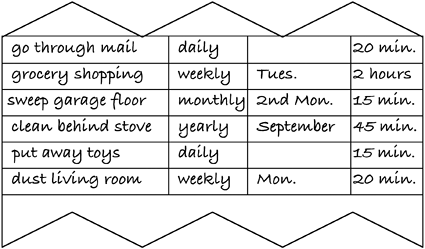
|

When
making your time estimates, remember to include time for the setup and
wrap-up phases, too. If you think it's unlikely that all three phases
will be completed without interruption by the same family member, then
consider splitting the task and listing it as two or three separate
tasks. For example, you may have a weekly item on your list called
“grocery shopping.” The setup phase involves creating a grocery shopping
list. The actual task is going to the grocery store, buying the items
on the list, and bringing them home. The wrap-up phase requires the
groceries to be put away. You must decide whether you are more
comfortable listing this as one item:
| Shop for groceries | weekly | Tuesday | 2 hrs. |
or as three items:
| Make grocery list | weekly | Monday | 25 min. | | Shop for groceries | weekly | Tuesday | 1 hr. 15 min. | | Put away groceries | weekly | Tuesday | 20 min. |
|
Dividing Your Master List into Time-Specific Lists
Your master list is
now complete! Don't make the mistake, though, of thinking that a master
list is the same as a schedule. You still have a few more steps to go
before you will have created a master schedule. The next step to success
will be for you to take your master list and split it into 20 separate
lists. Don't worry; you've already done the groundwork, so this phase
will be quick and easy.
Turn to a new
page in your spiral notebook and copy from your master list all of the
items you've indicated your family will do every day. Then create seven
lists—one for each day of the week—and transfer your weekly and monthly
items to them. Next, make 12 more lists—one for each month—and transfer
your yearly household maintenance tasks. You'll end up with the three
different types of lists that are represented in Figure 8.
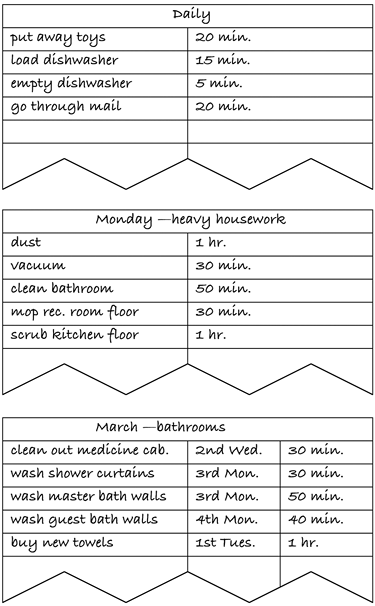
Making Sure It All Adds Up
You may have noticed
that you have a huge amount of stuff to do. Before you get totally
overwhelmed, it's time for a reality check. Each person gets 24 hours in
a day. You must subtract from that a minimum of 8 hours for sleep,
leaving 16 hours. If you're talking about someone who is working a
40-hour/week job, then five days a week his daily discretionary time is
reduced to 8 hours, before you even take into account commuting time and
personal care time. If you're talking about a toddler, then you don't
even need to begin calculating her discretionary time because the truth
is, she's not going to contribute in any significant way to
accomplishing any of the tasks you've put on your master list; even if
she's helping, you'll have to be next to her every step of the way.
So, what do you do if it's
obvious that the things you have on your to do list are going to take
more time than you have? First, look to see whether the situation can be
resolved simply by rearranging the list. For example, maybe you have a
lot more to do on a yearly basis in your bedrooms than you do in your
kitchen. If that's the case, you could divide the bedroom work between
two months and double-up the kitchen with another light month. If, on
the other hand, your time estimates simply add up to way more hours than
there are in a year, you'll have to consider some other alternatives.
In fact, you should consider those alternatives in any event because
they are all designed to let you accomplish more in less time.